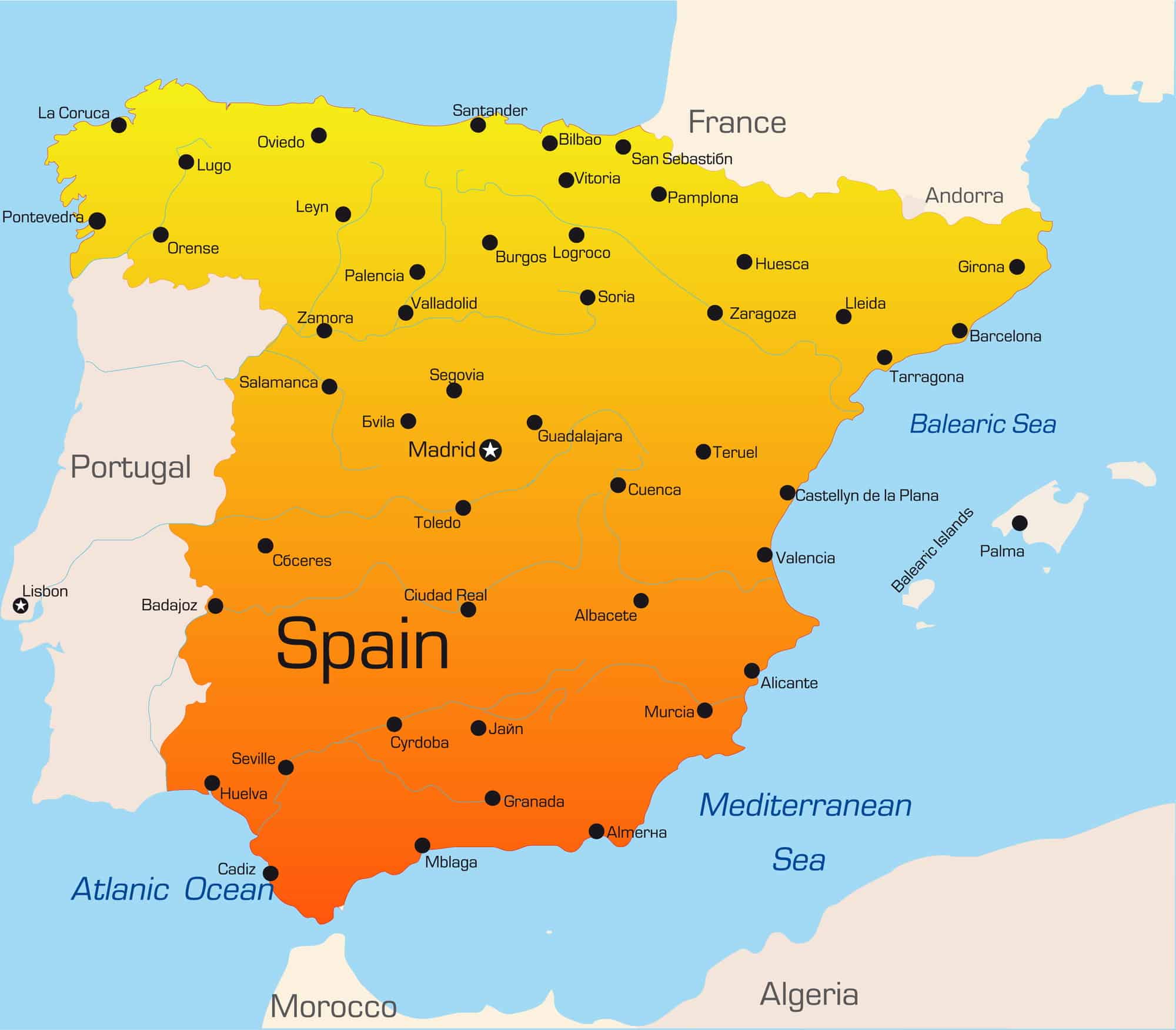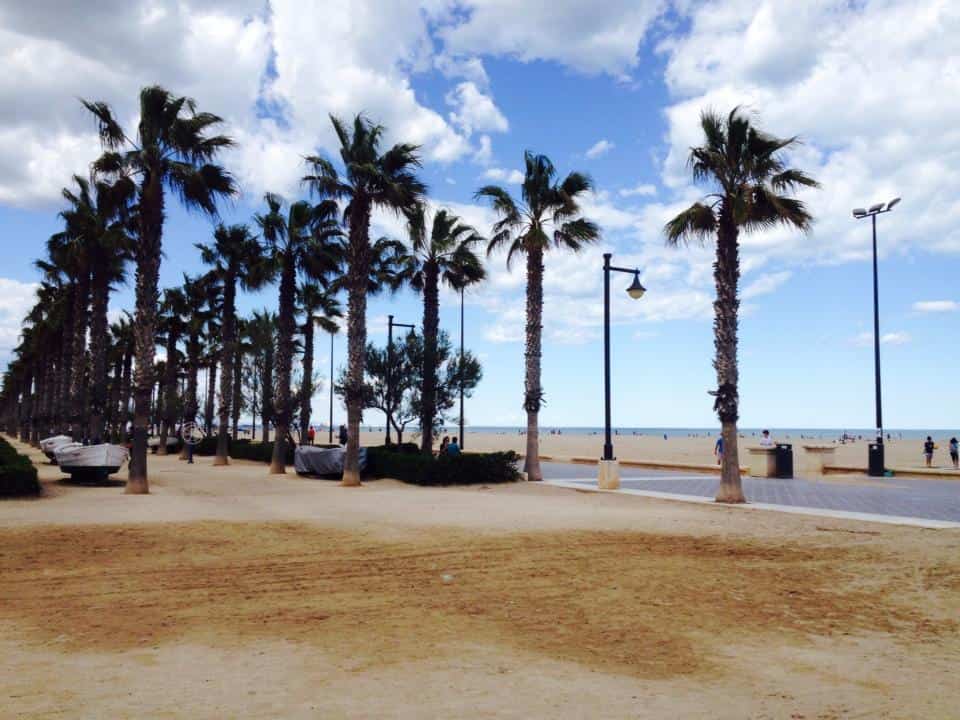Weather and Climate of Spain
Many people wonder if Spain has a tropical climate. After living in the country for several years, I can tell you that the answer is not straightforward. The country experiences diverse weather conditions because of the different climate types in each region.
Some parts of Spain have a subtropical climate, like parts of the northeastern region. However, the country is not considered tropical. The tropics surround the equator, and Spain is not located within those latitudes.


Hi, we’re Timon & Filipa!
We travel across Spain in our motorhome, Speedy, and update TravelSpain24 with fresh content, practical tips, and personal stories from the road. Our goal is to help you experience Spain beyond the typical tourist trails.
Is Spain tropical or subtropical?
To tell if parts of Spain are tropical or subtropical, we need to know what these two climates are like.
A tropical climate is where it’s warm all year round, with temperatures always above 18°C (64°F). There are also wet and dry seasons. A subtropical climate is also warm but not all year. Here, temperatures are above 10°C (50°F) for at least eight months of the year.
Spain has both types of climates. Like most of Catalonia, the weather is humid and subtropical in the northeast of Spain. The climate is tropical in the Canary Islands, which are part of Spain but near Africa. But, most of Spain, especially the mainland, has a different type of climate: neither tropical nor subtropical.
What are Spain’s various climate types?

Spain’s climates types are quite diverse, and the country is the most climatically diverse country in Europe with 13 different climates. However, most regions in the country can be categorized into the following major climates: continental climate, oceanic climate, Mediterranean climate, and subtropical climate. In the following sections, I’ll provide an overview of each one to help you understand the various weather conditions you may experience in the different regions of Spain.
Continental Climate

The central plateau of Spain has a continental climate with significant temperature swings. It’s usually dry with little rainfall. I personally find beauty in the contrast between the seasons. While living in Madrid for two years, I remember bundling up on chilly winter nights and then seeking shade a few months later and sipping ice-cold drinks when the summer heat arrived. The arid conditions lead to captivating landscapes that change during the year. And yes, contrary to what you might think, it does snow in some parts of Spain.
Oceanic Climate
The oceanic climate is typical for coastal regions in Spain’s northwest areas. While in Madrid, I had the unique opportunity to venture up north to explore Spain’s gorgeous coastline, spanning from Galicia to the Basque Country. I decided to rent a car to immerse myself in this rich experience. For anyone considering doing the same, I highly recommend Discover Cars for their excellent service and wide range of options.
The oceanic climate, with cooler temperatures and more rain, was a refreshing change. I fondly remember visiting coastal towns like Gijón in Asturias and Bilbao in the Basque Country. The area’s bright green scenery, misty coastal air, and warm-hearted locals created an enchanting experience I’ll never forget.
Mediterranean Climate

The Mediterranean climate is named after the Mediterranean Sea. This kind of weather is found on Spain’s east and south coasts. It reaches from the Costa Brava in the northeast to the sunny beaches of Costa del Sol in the south. This area includes regions like Catalonia, Valencia, Murcia, and Andalusia. This is where I spent most of my time.
So, let me tell you about my time on the beautiful southern coasts of Spain! I spent countless sun-soaked days basking in the Mediterranean climate, which is all about hot, dry summers and mild winters. As a beach lover, it felt like I had found my paradise. I still remember those warm afternoons spent lounging under palm trees, reading books, and just lying in the sun.
I also took a Spanish class in the lively city of Valencia. It wasn’t just about learning the language. I also got to experience the local culture and way of life. People there enjoy a relaxed pace of life, which is fun to be a part of. If you are contemplating a visit, consider checking our guide on whether visiting Valencia is worthwhile.
Subtropical Climate

The weather amazed me during my trip to the Canary Islands. The subtropical climate in lower areas like Santa Cruz de Tenerife and Las Palmas de Gran Canaria is pretty warm, even in the chilliest months. Temperatures are nice and steady all year round, somewhere between 18 – 24°C (64 – 75°F). One thing I won’t forget is hiking through the incredible landscapes of the islands. As I took in the unique views, I came across some of the most charming little villages I’ve ever seen.
By the way, the Canary Islands are where you find this subtropical climate in Spain. These islands are located off the coast of Africa but are part of Spain. This same climate is also found in certain parts of mainland Spain. A good example is the region of Catalonia. One of these places is the region of Andalusia, specifically its coastal areas such as Costa del Sol. While it’s usually not as warm as the Canary Islands, the temperatures are still pleasant, making it an ideal place to visit at any time of the year.
Some types of lesser-known climates in Spain
Throughout my travels in Spain, I’ve encountered some microclimates in the country that didn’t quite fit into the abovementioned categories. As a travel blogger, I’m always looking for extraordinary experiences to share with my readers, and the Pyrenees is one of them. Unlike the warm, coastal regions, this mountain range has a much cooler climate and stunning mountain views.
Another fascinating climate zone is southeastern Spain’s semi-arid (somewhat dry) region, particularly around Almería. Exploring Spain’s almost desert-like region is a real adventure, exemplifying the country’s incredible diversity. If you’re ever in this area, I highly recommend taking the time to discover this remarkable and lesser-known side of Spain. It will be an experience you won’t forget!
Spanish city’s average temperatures
| City | Average Low | Average High | Average Sea Water |
|---|---|---|---|
| Madrid | 6°C (42°F) | 21°C (70°F) | – |
| Barcelona | 9°C (48°F) | 21°C (70°F) | 13°C (56°F) |
| Valencia | 12°C (53°F) | 23°C (73°F) | 17°C (62°F) |
| Seville | 12°C (53°F) | 24°C (76°F) | – |
| Malaga | 12°C (54°F) | 23°C (74°F) | 18°C (65°F) |
| Bilbao | 9°C (48°F) | 18°C (64°F) | 15°C (59°F) |
| Granada | 7°C (45°F) | 19°C (66°F) | – |
| Palma de Mallorca | 10°C (50°F) | 22°C (71°F) | 18°C (64°F) |
| Zaragoza | 7°C (44°F) | 22°C (71°F) | – |
| Murcia | 11°C (51°F) | 24°C (76°F) | – |
Spain’s Climate by Months

During January and February, Spain’s weather ranges from relatively mild in the Mediterranean region to much colder in the northern areas like the Pyrenees Mountains. If you’re curious about the chillier side of Spanish life, you might want to explore some of Spain’s coldest places. The average temperatures in these months go from 12°C (53°F) in the Costa Tropical to as low as -1°C (30°F) in parts of the Pyrenees.
When we reach March, April, and May, the temperatures start to rise across the country. The spring is an ideal time to visit Spain because the temperatures are warm and comfortable without much precipitation.
In June, July, and August, Spain experiences very hot and sunny weather, especially in the south. July is considered the driest month, while the coastal areas of Galicia in the northwest still experience mist and fog due to the prevailing off-shore winds and high humidity.
The temperatures in Spain finally start to cool down as we enter September, October, and November. During this period, rainfall increases, with November usually being the wettest month in some regions. Nevertheless, fall is still a good time to visit Spain due to fewer crowds and more affordable accommodations.
The Weather and Climate of Spain in Conclusion
In conclusion, Spain is a country of diverse climates, not purely tropical or subtropical but a mix of several climate types. Each region’s unique weather conditions contribute to the country’s rich cultural and natural diversity. Spain has something to offer you if you’re a fan of snowy winters, sun-soaked beaches, or mild and rainy regions. If you want to make the most of your budget, you can even check out some of Spain’s cheapest places to live. Its climate diversity is just one of the many reasons I fell in love with this beautiful country, and I’m sure you will too.
Search the site
Popular Destinations
Just letting you know
When you buy something through our links, we’ll earn a small commission—don’t worry, it won’t cost you any extra! It’s a win-win, right?
Exclusive Heymondo Travel Insurance Offer
Planning a trip? Make sure you’re covered! We’ve teamed up with Heymondo to give our readers a special deal: 5% off travel insurance. Grab this deal and know you’re looked after on your next trip.








